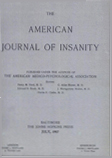Abstract
The structurality of dementia præcox is evidenced in the twelve cases just considered, for they show quite uniform pathological findings which are due neither to arteriosclerosis, senility nor a long continued grave toxic process.
This pathological process is essentially a chronic one resulting in an atrophy of the nerve cell body and its nucleus, a disappearance of its stainable substance, an attenuation with partial fragmentation of its neurofibrils and an atrophy with distortion of its protoplasmic prolongations; the process terminating in either extreme pyknotic atrophy in which the shrunken cell and its prolongations are seen covered with incrustations or in a fragmentation of the nerve cell to the extent that it is either a shadowy outline or an atrophic nucleus surrounded simply by a fragmented rim of pale granular protoplasm.
The neurofibrils of the nerve cells show a marked atrophy with foci of fragmentation and loss in both the cell body and its prolongations. Their appearance bear no resemblance to the disintergration of the neurofibrils and the peculiar rotting off of the processes in general paralysis of the insane nor to the whorls and loop formations of senile dementia and Alzheimer's disease. The more acutely degenerated nerve cells show marked fatty deposits in abnormal positions or entirely filling the cell bodies. The fat granules are seen in the axis cylinders and apical processes and frequently outlining the cell prolongations. The glial nuclei, especially of the molecular and infrastellate strata, show an irregular stippling with fine fat granules. The adventitial cells of the blood vessel walls and occasionally of the vessel luminæcontain large amounts of lipoidal material.
The glial structures show varying degrees of regressive changes. Shrunken, frequently irregular, diffusely staining glial nuclei are seen in both grey and white substance. Fiber forming types in all stages of regression from the large protoplasmic bodies to the shrunken nuclei with exceedingly coarse fibers are seen in several cases forming foci of gliosis in the molecular and infrastellate strata. The surface mat quite generally shows an increase in width with focal extensions of its coarse fibers into the zonal layer.
The ameboid types of glial cells observed in these cases are not those found in acute terminal processes. Acute satellitosis is insignificant and inconstant. Neurophages are found closely approximated to the more acutely degenerating nerve cells or lying in lacunæ of their cell protoplasm. They are seen attacking irregularly the nerve cells of all layers and are noticeably absent in regions in which the destructive processes are of long duration. The cerebella in three cases examined showed destruction of the nervous tissues, more marked on the summits of the convolutions and decreasing toward the bases. Over the summits the Purkinje cells are extremely atrophic and pyknotic in appearance. Along the sides and bases they show varying degrees of more acute alterations. There is a patchy loss of these cells. In case 707 a rather high grade glial proliferation is observed.
Considered from the regional point of view the organic changes observed in these cases were generally found most severe and of a more chronic nature in the frontal regions, though several of the cases showed the involvement most severe in the central regions. There is a surprising difference in the degree of the alterations in the two hemispheres, those in the right being usually much more recent and acute in type. Stratigraphically the first, second and third nerve cell layers show the most severe involvement, the severity and diffuseness of the changes decreasing toward the third stratum. There is a singular fragmentation of the stellate nerve cell stratum in all these cases.
While there has been no special effort in the present work to trace the disease process, a general impression is obtained from the study of the various types of cells in all strata that the initial process is one of moderate swelling of both cell body and nucleus followed by a gradual breaking down of the normal nuclear chromatin structure; later by an atrophy and fragmentation of the neurofibrils with subsequent granular degeneration and irregular clumping of the Nissl granules; the final stage terminating in one of two conditions according to the degree of the vicious influences or the original resistance of the cell, viz.: moderate atrophy followed by more or less acute fragmentation and extreme pyknotic atrophy.
Underlying the arteriosclerotic and senile changes in the cortices of the 40 other præcox cases mentioned but not reported here are similar pathological changes which are readily recognized except where the superimposed alterations are sufficiently severe to mask the original ones. It seems, therefore, possible to assume that the changes described in the cases presented are pathognomonic of dementia præcox.

